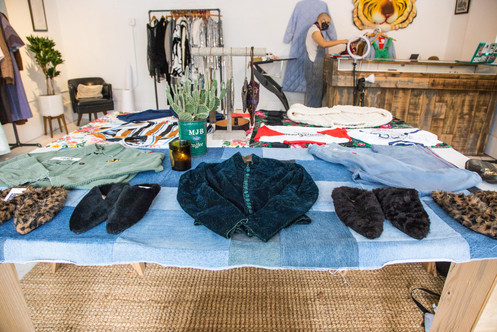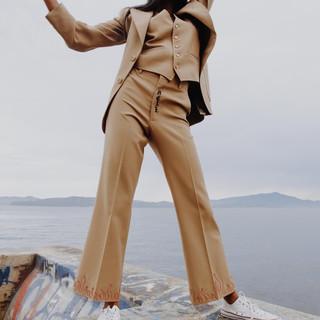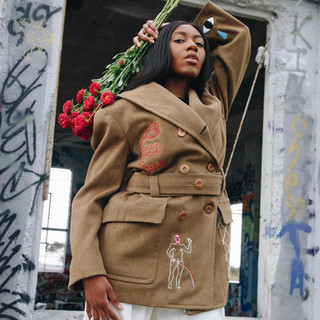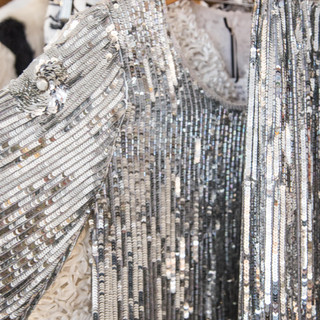BabaYaga Vintage Shop : Feminism, Transformation & Fairytales
- Sandy Fin
- Nov 13, 2020
- 5 min read
Updated: Nov 4, 2025
What does the name of your store mean?
Baba Yaga is a witch from Slavic folklore. When picking names for the store, my Mom and I wanted something unique that represented powerful femininity—the decision to name our shop after a mythological witch felt really fitting for us. Furthermore, I know my Mom feels connected to the theme of transformation in her fairytale and its relation to fashion, femininity, and aging.
What is your story? Russia?
My background is actually not Russian, though I get this question a lot due to the store name being 'Baba Yaga.' My Dad is Ecuadorian, and I'm the first generation on his side of the family, and my Mom's side of the family is Ukrainian.
Are you an artist/maker? (I see you mending or sewing when I have come into the store? Personal attention to the garments)
I'm primarily a self-taught artist and maker, although I've taken classes in pattern making and sewing and a few art classes here and there. I taught myself how to embroider and took on a side gig for a while, doing custom embroidery. I love to upcycle vintage and make custom pieces for the shop as often as I can! I also repair all of the vintage pieces that come in by hand. We put a lot of love into everything that goes on the floor, and restoration is definitely an element of that.

How did you start your business? What were you doing before?
My Mom and I had talked about opening a store together since I was in high school. We both love vintage and actually started an online store when I was a sophomore. After graduation, I moved to Seattle for a bit and came back to pursue a patternmaking certification and finally took the leap of opening a brick and mortar with my Mom. This spot on Caledonia came available, and we jumped on it.
And how have you managed to stay open during these uncertain times?
During the initial few months of quarantine, we had to shut down completely. To cope with the sudden change, I spent each day photographing pieces to sell through our Instagram stories and did contactless free delivery for all of our Marin customers. We were unable to source new inventory for a while due to the shutdown, so I took to upcycling as much of our backstock as I could as a way to turn out new pieces. We've since been able to reopen and can source vintage again!
Upcycling and doodling on clothes -the current trend in fashion? Back in the day, I remember doodling on my jeans with my blue-jeans in class.
Upcycling is definitely gaining popularity throughout the fashion world. I think sustainability is becoming increasingly more important for brands and consumers alike. There are some great new designers making specialty pieces from repurposed materials and clothing right now! I think this approach to fashion allows for so much creativity.
For my upcycled doodle clothing, I mostly draw inspiration from tattoo artists. I really love stick and poke designs as well as ignorant style and traditional tattoos. To answer your question above, yes, I think doodle clothing is absolutely on-trend right now! Senior cords (hand-drawn corduroy skirts and pants popularized by Indiana high schoolers) have also become highly collectible pieces in the last few years from a vintage perspective.

Tell us about some of the artists you carry, and what inspired you about their work?
T-shirts by Marcelina Amelia: Her ability to draw on elements of female sexuality, fairytales, and dreams and how she weaves them into her unusual and eye-catching t-shirt design.
Holly Simple Tarot: I love that her zine-maker roots shine through her illustrations and her tarot guidebook. It makes for a really unique experience when using her deck.
Jewelry by Red Sofa: I'm inspired by how Joanna Szkiela highlights the beauty of asymmetry through her use of natural elements in her designs.
Socks and jewelry by Coucou Suzette
Gift items by Sarah Judge: Amazing independent collage artist! We carried her iconic t-shirt and candle designs she made using collaged 70s porn.
Clothing by Brit Wacher: I'm inspired by her sensational structural design and her pursuit of empowering women through fashion.
Also, I'm currently hard at work on a small capsule collection of upcycled pieces for Baba Yaga!

I always learn something new about fashion trends /designers when I am at your shop? Many are treasures and exceptional finds- of course, hard to come by- There is a Mexican designer colorful, reminds me of the Pucci of Mexico. Take me through the story + other pieces.
Yes! The Girasol skirt is a stunner. It was made in the 1960s by the Mexican designer brand, Girasol (the Spanish word for 'sunflower'). Headed by designer Gonzalo Bauer. We've carried a handful of Girasol pieces over the years, mostly their iconic 80s jackets with colorful folk art patches of animals, which I believe are inspired by alebrijes (mythological animal spirits).
What drew us to the skirt, beyond our love for Girasol, was the neon embroidery against the beige wool body. Neon and neutrals are always a winning combo! Not to mention the cute fringe along the hem.
Our 1940s Canadian Frontiersman jacket with chainmail shoulders is another interesting piece we have in stock. The jacket is from a civilian-military group originally founded in Britain with branches in Canada and Alaska. In the 1930s the Canadian branch cut ties with Britain and began working alongside the Canadian mounted police. The chainmail detailing is original to the uniform. I was able to date it by the patches, buttons, and by using historical photo references.
Do other current + past garments have a personal story for you?

The first piece that comes to mind is a rare fur jacket my Mom sourced. I was immediately intrigued by the unusual tag it came with and went down a research rabbit hole trying to date it and pinpoint its origins. The manufacturer's name on the back of the tag reads, 'Sir Titus Salt's Co. Saltaire, Eng.' Sir Titus was an English manufacturer and politician from the 1800s who opened a textile mill in the town of Saltaire. He was beloved for prioritizing his employees' living and working conditions and had started the town of Saltaire to

create a manufacturing environment that paid better wages and cut down on pollution. There was limited information available online, so I ended up contacting the Saltaire Historical Society directly. The researchers I got in touch with sent me more information on the jacket, and I learned that it was made in the early 1900s after Salt's son took over the company. Briefly, in the late 1800s and early 1900s, his son had opened another manufacturing site on the East Coast, where the jacket was made.
Unfortunately, the jacket was made of Seal fur, which is not legal in the United States, so we decided to give it to the Historical Society. It's now archived and on display in their museum!
© 2020-2025 withitgirl. All rights reserved. We appreciate your feedback!




























Comments